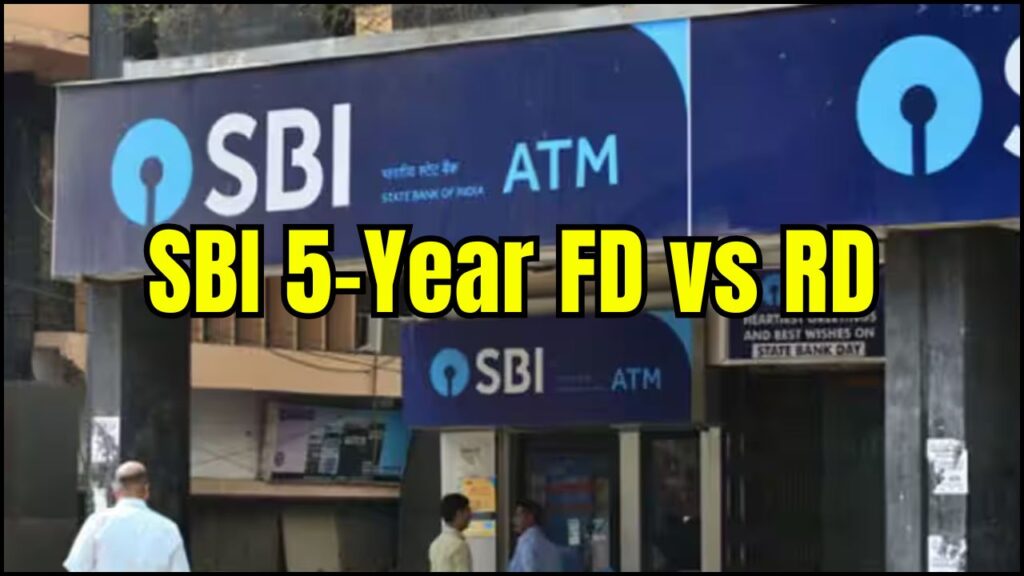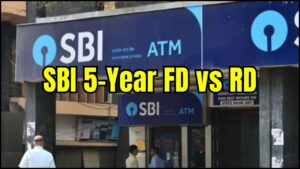
For Indian savers considering the SBI 5-Year FD vs RD debate, choosing the most rewarding option for a ₹7 lakh investment depends on timing, liquidity needs, and interest accumulation. This analysis compares both products based on the latest interest rates, maturity values, and investor profiles, drawing from verified financial data and institutional sources.
SBI 5-Year FD vs RD
Both Fixed Deposits (FDs) and Recurring Deposits (RDs) offered by the State Bank of India (SBI) are widely trusted instruments for risk-averse investors. However, the maturity value and interest returns from these instruments differ significantly, especially when the investment amount, such as ₹7 lakh, is deployed either as a lump sum or in monthly installments.
Key Distinctions in Deposit Structure
- Fixed Deposit (FD) requires a one-time lump sum investment, allowing the entire amount to earn interest from day one.
- Recurring Deposit (RD) involves monthly contributions, where each installment earns interest for a progressively shorter period.
While both schemes offer capital protection and guaranteed returns, the time value of money plays a decisive role in return differentials.
SBI’s Latest Interest Rates for 5-Year FD and RD
As of September 2025, the State Bank of India offers the following rates for 5-year deposit products:
| Deposit Type | General Public Rate | Senior Citizen Rate |
|---|---|---|
| SBI 5-Year FD | 6.05% p.a. | 6.55% p.a. |
| SBI 5-Year RD | 6.50% p.a. | 7.00% p.a. |
Comparative Returns: ₹7 Lakh Investment
Lump Sum in SBI 5-Year Fixed Deposit
Assuming a lump sum investment of ₹7 lakh at 6.05% p.a. (compounded quarterly):
- Maturity Amount: ₹9,46,000 (approximate)
- Total Interest Earned: ₹2,46,000
- Interest is fully taxable under the investor’s income tax slab.
Monthly Investment in SBI 5-Year Recurring Deposit
Assuming ₹11,667 is deposited every month over 60 months at 6.50% p.a.:
- Total Investment: ₹7,00,020
- Maturity Amount: ₹8,00,000 to ₹8,05,000 (approximate)
- Total Interest Earned: ₹1,00,000 to ₹1,05,000
While the RD offers a higher nominal interest rate, the total return is lower due to staggered capital infusion and reduced compounding benefit.
Tax Implications for FD and RD Investors
Both FD and RD returns are taxed as per the individual’s income tax slab:
- Tax Deducted at Source (TDS) applies on interest exceeding ₹40,000 per financial year (₹50,000 for senior citizens), under Section 194A of the Income Tax Act.
- Investors can submit Form 15G/15H to avoid TDS if total income is below the taxable threshold.
As interest is not exempt, net returns may significantly reduce for those in the 20–30% tax brackets. Tax-saving fixed deposits, with a lock-in of 5 years, offer limited exemptions under Section 80C.
Who Should Choose Which?
Fixed Deposit: Best for Lump Sum Investors
- Immediate availability of capital
- Prefer capital protection and certainty
- Require passive income via periodic interest payout options
Recurring Deposit: Suitable for Monthly Savers
- No large upfront funds
- Suitable for salaried individuals
- Builds a savings habit over time
Inflation and Real Returns: A Hidden Factor
With India’s retail inflation averaging around 5.5% (as per latest Reserve Bank of India data), real returns on both FD and RD remain marginal. Post-tax and inflation-adjusted returns may fall below 2% for individuals in higher tax brackets.
Experts recommend diversifying part of the corpus into market-linked instruments such as debt mutual funds or sovereign gold bonds for potentially better real returns.
Rupee Crashes to Record Low of ₹88.27 Against Dollar: Check Details
Conclusion
For individuals with ₹7 lakh readily available, the SBI 5-Year Fixed Deposit provides superior returns compared to a recurring deposit, despite a slightly lower interest rate. However, investors must consider their liquidity, tax liabilities, and long-term goals when making a choice. The decision between FD and RD is not solely about returns but also about financial flexibility and discipline.
















